















|
Advance in science comes by laying brick upon brick, not by sudden
erection of fairy palaces.
- J. S. Huxley
Venus, the jewel of the sky, was once know by ancient astronomers as the morning star and evening star. Early astronomers once thought Venus to be two separate bodies. Venus, which is named after the Roman goddess of love and beauty, is veiled by thick swirling cloud cover.
Astronomers refer to Venus as Earth's sister planet. Both are similar in size, mass, density and volume. Both formed about the same time and condensed out of the same nebula. However, during the last few years scientists have found that the kinship ends here. Venus is very different from the Earth. It has no oceans and is surrounded by a heavy atmosphere composed mainly of carbon dioxide with virtually no water vapor. Its clouds are composed of sulfuric acid droplets. At the surface, the atmospheric pressure is 92 times that of the Earth's at sea-level.
Venus is scorched with a surface temperature of about 482° C (900° F). This high temperature is primarily due to a runaway greenhouse effect caused by the heavy atmosphere of carbon dioxide. Sunlight passes through the atmosphere to heat the surface of the planet. Heat is radiated out, but is trapped by the dense atmosphere and not allowed to escape into space. This makes Venus hotter than Mercury.
A Venusian day is 243 Earth days and is longer than its year of 225 days. Oddly, Venus rotates from east to west. To an observer on Venus, the Sun would rise in the west and set in the east.
Until just recently, Venus' dense cloud cover has prevented scientists from uncovering the geological nature of the surface. Developments in radar telescopes and radar imaging systems orbiting the planet have made it possible to see through the cloud deck to the surface below. Four of the most successful missions in revealing the Venusian surface are NASA's Pioneer Venus mission (1978), the Soviet Union's Venera 15 and 16 missions (1983-1984), and NASA's Magellan radar mapping mission (1990-1994). As these spacecraft began mapping the planet a new picture of Venus emerged.
Venus' surface is relatively young geologically speaking. It appears to have been completely resurfaced 300 to 500 million years ago. Scientists debate how and why this occurred. The Venusian topography consists of vast plains covered by lava flows and mountain or highland regions deformed by geological activity. Maxwell Montes in Ishtar Terra is the highest peak on Venus. The Aphrodite Terra highlands extend almost half way around the equator. Magellan images of highland regions above 2.5 kilometers (1.5 miles) are unusually bright, characteristic of moist soil. However, liquid water does not exist on the surface and cannot account for the bright highlands. One theory suggests that the bright material might be composed of metallic compounds. Studies have shown the material might be iron pyrite (also know as "fools gold"). It is unstable on the plains but would be stable in the highlands. The material could also be some type of exotic material which would give the same results but at lower concentrations.
Venus is scarred by numerous impact craters distrubuted randomly over its surface. Small craters less that 2 kilometers (1.2 miles) are almost non-existent due to the heavy Venusian atmosphere. The exception occurs when large meteorites shatter just before impact, creating crater clusters. Volcanoes and volcanic features are even more numerous. At least 85% of the Venusian surface is covered with volcanic rock. Hugh lava flows, extending for hundreds of kilometers, have flooded the lowlands creating vast plains. More than 100,000 small shield volcanoes dot the surface along with hundreds of large volcanos. Flows from volcanos have produced long sinuous channels extending for hundreds of kilometers, with one extending nearly 7,000 kilometers (4,300 miles).
Giant calderas more than 100 kilometers (62 miles) in diameter are found on Venus. Terrestrial calderas are usually only several kilometers in diameter. Several features unique to Venus include coronae and arachnoids. Coronae are large circular to oval features, encircled with cliffs and are hundreds of kilometers across. They are thought to be the surface expression of mantle upwelling. Archnoids are circular to elongated features similar to coronae. They may have been caused by molten rock seeping into surface fractures and producing systems of radiating dikes and fractures.
| Animations of Venus |
|---|
| Views of Venus |
|---|
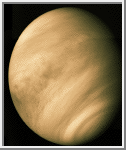 Mariner 10 Image of Venus
Mariner 10 Image of Venus
This beautiful image of Venus is a mosaic of three images acquired by
the Mariner 10 spacecraft on February 5, 1974.
It shows the thick cloud coverage that
prevents optical observation of the surface of Venus. Only through
radar mapping is the surface revealed.
(Copyright Calvin J. Hamilton)
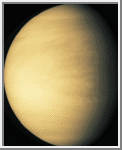 Galileo Image of Venus
Galileo Image of Venus
On February 10, 1990 the Galileo spacecraft acquired this image of
Venus. Only thick cloud cover can be seen.
(Credit: Calvin J. Hamilton)
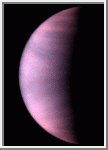 Hubble Image of Venus
Hubble Image of Venus
This is a Hubble Space Telescope ultraviolet-light image of the
planet Venus, taken on January 24, 1995, when Venus was at a distance of
113.6 million kilometers from Earth.
At ultraviolet wavelengths cloud patterns become distinctive. In
particular, a horizontal "Y" shaped cloud feature is visible near
the equator.
The polar regions are bright, possibly showing a haze of small
particles overlying the main clouds. The dark regions show the
location of enhanced sulfur dioxide near the cloud tops. From previous
missions, astronomers know that such features travel east to west along
with the Venus' prevailing winds, to make a complete circuit around the
planet in four days.
(Credit: L. Esposito, University of Colorado, Boulder, and NASA)
 Venus
Venus
This is a global view of the surface of Venus centered at 180
degrees east longitude. Simulated color is used to enhance
small-scale structure.
(Courtesy NASA/JPL)
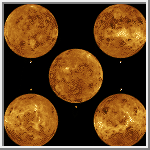 Five Global Views
Five Global Views
The surface of Venus is displayed in
these five global views. The center image (A) is centered
at Venus' north pole. The other four images are centered
around the equator of Venus at (B) 0 degrees longitude, (C)
90 degrees east longitude, (D) 180 degrees and (E) 270
degrees east longitude. The
bright region near the center in the polar view is Maxwell
Montes, the highest mountain range on Venus. Ovda Regio is
centered in the (C) 90 degrees east longitude view. Atla
Regio is seen prominently in the (D) 180 east longitude
view.
(Courtesy NASA/JPL)
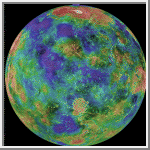 Hemispheric View of Venus
Hemispheric View of Venus
This hemispheric view of Venus, as revealed by more than a decade
of radar investigations culminating in the 1990-1994 Magellan
mission, is centered at 0 degrees east longitude.
The effective resolution of this image is about
3 kilometers. It was processed to improve
contrast and to emphasize small features, and was color-coded to
represent elevation.
(Courtesy NASA/JPL)
Additional Hemispheric Views of Venus
 Venusian Map
Venusian Map
 Venusian Topography Map
Venusian Topography Map
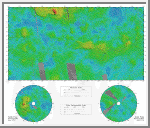 Venusian Topography
Venusian Topography
 Cylindrical Map of Venus
Cylindrical Map of Venus
 Gula Mons and Crater Cunitz
Gula Mons and Crater Cunitz
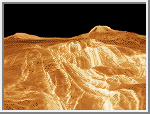 Eistla Regio - Rift Valley
Eistla Regio - Rift Valley
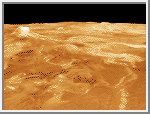 Eistla Regio
Eistla Regio
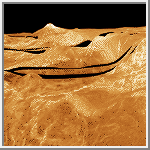 Lakshmi Planum
Lakshmi Planum
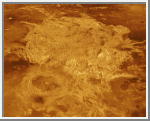 Three-Dimensional Perspective View of Alpha Regio
Three-Dimensional Perspective View of Alpha Regio
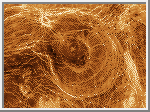 Arachnoids
Arachnoids
 Parallel Lines
Parallel Lines
 Surface Photographs from Venera 9 and 10
Surface Photographs from Venera 9 and 10
The Venera 10 Lander (bottom) touched down on the surface of Venus on
October 25, 1975 at 5:17 UT, about 16° N, 291° E. The Lander
was inclined about 8 degrees. It returned this image during the 65
minutes of operation on the surface. The sun was near zenith during this
time, and the lighting was similar to that on Earth on an overcast summer
day. The objects at the bottom of the image are parts of the spacecraft.
The image shows flat slabs of rock, partly covered by fine-grained material,
not unlike a volcanic area on Earth. The large slab in the foreground
extends over 2 meters across.
 Color Surface Photographs from Venera 13
Color Surface Photographs from Venera 13
On March 1, 1982 the Venera 13 lander touched down on the Venusian
surface at 7.5° S, 303° E, east of Phoebe Regio. It was the first
Venera mission to include a color TV camera. Venera 13 survived on the
surface for 2 hours, 7 minutes, long enough to obtain 14 images.
This color panorama was produced using dark blue, green and red
filters and has a resolution of 4 to 5 min. Part of the
spacecraft is seen at the bottom of the image. Flat rock slabs and
soil are visible. The true color is difficult to judge because the
Venerian atmosphere filters out blue light. The surface composition
is similar to terrestrial basalt. On the ground in the foreground is a
camera lens cover. This image is the left half of the Venera 13 photo.
| References |
|---|
Ford, John P. et al. Guide to Magellan Image Interpretation. JPL Publication 93-24, 1993.
Robinson, Cordula. "Magellan Reveals Venus." Astronomy, 32-41, February 1995.

 Return to Mercury
Return to Mercury
 Home to Earth
Home to Earth
